Violet and Stewart Bennett bought Scotsdale Farm in
1938, and it was through their bequest to the Ontario Heritage Trust in 1982
that the Farm is preserved for future generations to enjoy. Situated on the
edge of the Niagara escarpment and accessible from Trafalgar Road, the
Farm is about eight km. north of the Georgetown area and 1.6 km. south of
Ballinafad.
The Early Years
Originally there were several entrances into
the main farm: the entrance into the Front Bush, now closed to vehicle traffic,
led into what is now a section of the Bennett Heritage Trail. A short distance
from this now closed front entrance on the crest of Blue Mountain Hill
was a huge stone at Scotsdale’s peak. At one time, on a clear day,
and before the pines on the hill below obscured the view, the blue of Lake
Ontario, nearly sixty kilometers (40 miles) away, could be seen while standing
on this stone. “Blue
meeting blue.”
The most used entrance during the early years was
the cinder road laid along the north edge of Scotsdale’s front field
facing the seventh line. Traces of this service road, which led to the
farm manager’s house, still remain. Although it is now gone, the first welcome,
for many decades, was a fine American elm which stood in the middle of
this gently rolling field.
The principal entrance now borders the south side
of this same field and leads more directly to the main house.
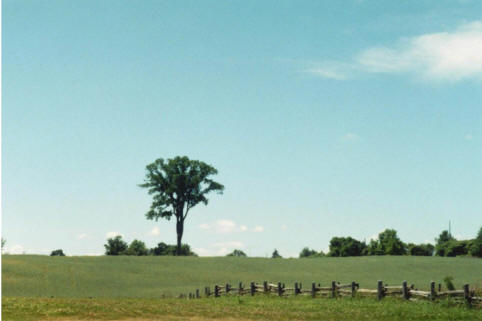
The American
Elm (Photo by Mary Carey)
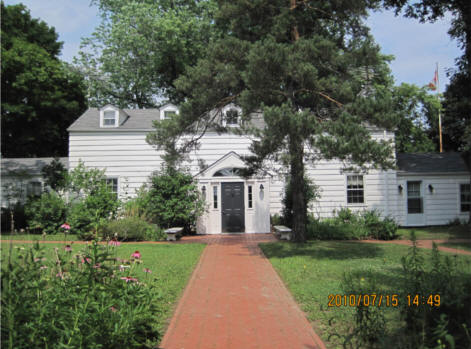
The Main House, 2010 (Photo by Janice Treciokas)
Expansion
of Scotsdale
In the 1940’s, Scotsdale expanded from the original 1938 purchase of the
pioneer Cooke family homestead to include several other properties:
On the eighth line, the 100-acre Wylie
Place and the Shortill farm immediately south of it.
On the seventh line, the Brennan farm
located on the northeast corner of the sideroad above Silvercreek and on the
opposite side of the road, the (Miller) house and barn.
The Riddell bush property, which lay
between the Brennan Farm and the main farm, is now home to a section of the
Bruce Trail.
The Harding Price Farm directly across
from Scotsdale’s front field on the seventh line was purchased in 1952. The purchase of these properties helped
accommodate the expanding farm operation and provided homes for the families of
the men who worked on the farm.
In 1943 Mr. Bennett hired Maurice Baker as herdsman
and shortly afterwards Mr. Baker became manager of Scotsdale. He was
instrumental in developing the purebred Shorthorn herd that won premier prizes
at the Royal Winter Fair and at the Chicago International Livestock Show.
Emerson Clarke followed as manager in 1961 and continued to develop the
renowned herd. Mr. Clarke retained the herd at the Farm after 1982.
The Early Years (development of the
shorthorn herd)
The 1940’s
After the war, Mr. Bennett
decided to purchase some purebred Shorthorn heifers in calf from Scotland. It was not a very safe passage for them
dodging mines in the Atlantic left from the war, but they all arrived safely.
From the several dozen cattle that Ontario shorthorn breeder, John Miller, had
brought to North America, Mrs. Bennett was given the courtesy of choosing the
last one of the twelve that Scotsdale would buy.
She chose Princess Deirdre, already in calf. Deirdre was the dam (mother) of Aspiration, the Bennett’s first grand
champion Shorthorn bull at the Royal Winter Fair in 1947.
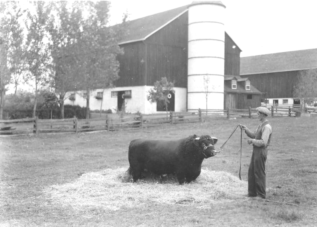
Aspiration, with Maurice Baker at the halter.
The original heritage barn is in the background.
(Photo by Mr. Bennett)
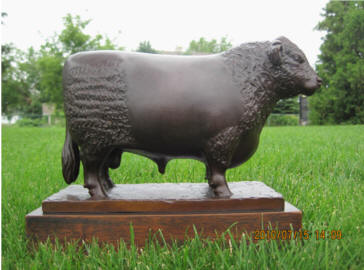
Bronze of Aspiration. (Photo by Emma Rath)
Mr. Bennett commissioned
noted artist and sculptor, Jacobine Jones, to do a bronze of
the prize-winning bull. Mr. Baker’s son, Grant Baker, who was five years old at
the time, watched Ms. Jones as she made the plaster cast of Aspiration on site
in the barnyard. Of the two bronzes made of Aspiration,
one of them now belongs to Grant.
The 1950's
By the early 1950’s, both of
the preeminent breeding bulls, Aspiration, who was born at the Farm, and
Mayflower Ransom, purchased earlier from the Ontario Agricultural College had
become impotent. Artificial insemination was still not a well-established
practice at that time, so Mr. Bennett and Mr. Baker went to Scotland in 1952
and Mr. Bennett was persuaded by Mr. Baker to buy Calrossie Prefect at the
Perth sale. Mr. Bennett made the final
bid paying 6100 guineas for the
bull…quite a sum in those days. Some would say astronomical! A measure of
inbreeding followed in the expanding herd and Scotsdale continued to rack up
prizes at the Royal Winter Fair
all
through the fifties
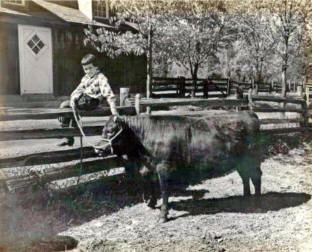
Mary Bennett Baker with Scotsdale Flower Victoria
Date: July 9, 1952, Photo taken by D. McElhinney.
Compliments of Cockshutt Farm Equipment Ltd., Brantford, Ontario.
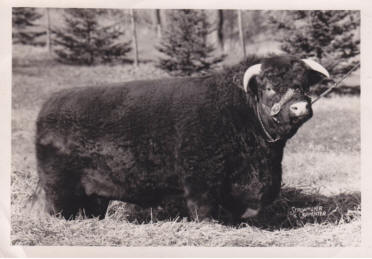
Calrossie Prefect
Photo taken by Strohmeyer & Carpenter
White Plains, New York
The white door seen in the photograph (left above)
is the south door of The New Barn, which
housed the breeding bulls. Inside, it assumed gallery proportions as a showcase
for the livestock. A wide corridor of impeccable cement was flanked on either
side by the livestock pens housing the bulls. With their massive heads and
their huge lumbering balls grazing the fresh straw, they were a formidable
presence.
Two Grand Champion
Shorthorn Bulls of the Fifties
The two photographs (below) by Jim Rose were taken in the show ring at the Royal
Winter Fair
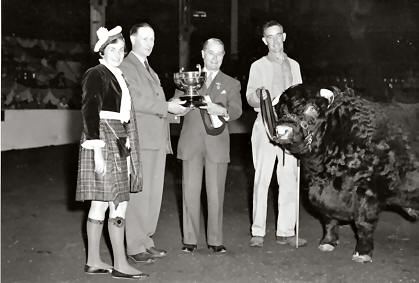
Mr. Bennett with the trophy for Scotsdale Jupiter in
1956
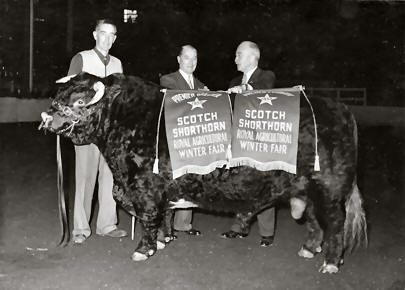
Scotsdale wins Premier Breeder and Exhibitor in 1959
Mr. Bennett became president of the Royal Winter Fair in
1953, after having served as vice president for two years.
An article appeared in the Financial Post in March of that
year profiling Mr. Bennett.
From Evelyn Baker’s Scrapbook
(copy of Post article below)
“The Royal
Agricultural Winter Fair in Toronto is the largest fair of its kind in the
world. This coming November it celebrates its 25th birthday.
Actually the Royal has been going longer than that, but during the war it
was suspended when the RCAF took over its buildings on the Canadian National
Exhibition grounds.
In the midst
of all the planning is farmer-industrialist Stewart Gordon Bennett who this
week became president of the Royal, after two years as a vice-president
President
Bennett also heads Beardmore & Co., which is one of Canada’s oldest leather
firms. It’s been operating since 1844. In addition, he is a director of
Dominion Stores, Chartered Trust, Phoenix Assurance, Canadian Bronze and
several other companies.
But 40 miles
away from his downtown Toronto office on dignified Victorian Front St. he’s
a farmer.
And it’s as
a farmer that he heads the Royal.
For 15
years, Mr. Farmer Bennett has lived on his 600 rolling, wooded acres at
Georgetown. There he has developed a prize-winning Shorthorn herd. Those
cattle are a pretty aristocratic bunch, and wear ribbons from the Royal and
Chicago. And when they come up for sale they wear price tags like $2,550,
and $4,800 and $5,700. Proud ones, they are.
But the
cattle on the Bennett farm take a backseat to the master of the bullpen—the
$20,000 1952 Supreme Grand Champion Bull which Bennett brought back from the
famous Shorthorn sale in Perth, Scotland.
Bennett was
born in Toronto, 60 years ago. His father was in the lumber business, at
different times had mills throughout parts of northern Ontario.
Stewart
graduated from University of Toronto in engineering, then headed for Oxford
to study political economy.
He was just
nicely in England in 1914 when Europe’s political economy blew up. And he
joined the Royal Engineers. At war’s end he came home to Canada, a captain
with an M.C. and a mention in dispatches. For six years he taught
engineering at his old alma mater, and in 1925 joined Beardmore’s.
Bennett has
seen much of the world on business and pleasure trips; Australia, New
Zealand, Cuba, South America, Mexico, U.K. and Western Europe.
In addition
to his business and farming interests, he’s on the board of the Toronto Art
Gallery, and is chairman of the tariff committee of the Canadian
Manufacturers’ Association. He is an Anglican, and a member of the York,
Toronto, Toronto Gold, and University clubs.”
More from Evelyn Baker’s Scrapbook
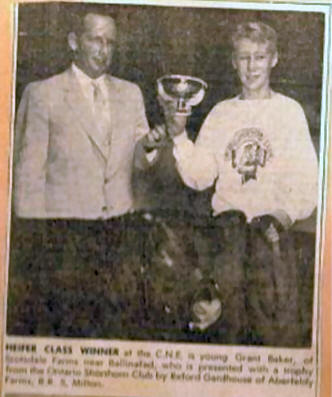
Heifer Class winner at the CNE is young Grant Baker
of Scotsdale
Farms near Ballinafad, who is presented with a trophy from the
Ontario Shorthorn Club by Reford Gardhouse of Aberfeldy Farms, R.R.5, Milton
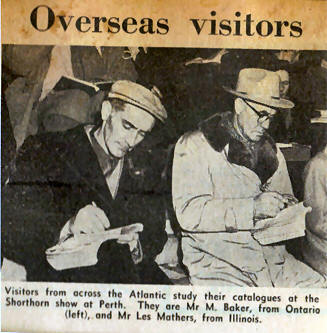
The photograph above would have been taken prior to
the 1952 Perth sale where
Mr. Bennett famously bought Calrossie Prefect for 6100 guineas
The Horses
The horses were a passion for Mr. Bennett and he bought the purebred
Arabians, Mihrima and Sahara, in Britain. Mihrima’s foal, Senob, was the first
horse born at the farm. Senob was known as Bones, which is Senob spelled
backwards.
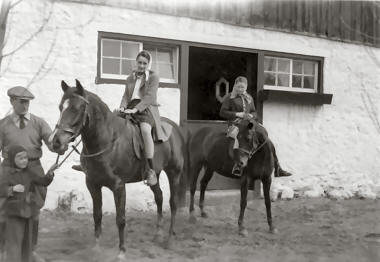
The Arabian horses with Mr.Bennett and Grant Baker
at the halter.
Janice Baker and Mary Ann Maxwell astride the horses.
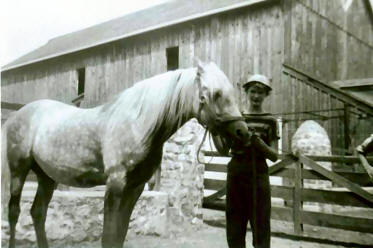
Betty Trott at the halter with Bones.
Before the Arabians were purchased, the Bennetts had two
Clydesdale horses, and in a taped segment that has been transcribed, Mr. Baker
recounts one occasion that lends some flavour to the early years.
“I remember once I took them over to O. D. Vaughn’s (Fallbrook
Farm) (on the side road past the eighth line, nearer to the ninth) …and hitched
them up; we had all the harnesses, the brass polished, the colours, the high
tops and the bridge sleigh; everything.
That time Mr. and Mrs. Bennett had a guest out who used to work
with Walt Disney; and she'd had quite a good job. Well, I had the horses out
hitched and everything shining and she came down just before we were about to go
and looked at them and then she said "Who wouldn't be a horse's ass if you could
look like that."
The Pond
The pond is a beautiful feature
of Scotsdale. It is fed by Snow’s creek from the north end of the property below
the manager’s house. The pond was created by a dam built just beyond the New
Barn on the northeast side of the cinder road. The dam was built to prevent
flooding in the lower fields as the flow tracks east and south. Below the dam
there was a small bridge that the various implements and trucks could cross to
access the back bush and fields. After the original bridge collapsed, the
Ontario Heritage Trust built a much sturdier one to replace it. In the early
years Alex Mitchell snow ploughed the roads and kept them clear through the back
bush to the eighth line. The Adams children from the Shortill property and the
Gates children from Fallbrook Farm were able to walk through this
back bush road to reach Blue Mountain School on the seventh line. This walking
route saved them a much longer roundabout trek.
The wishing well, right at the
edge of the pond opposite the New Barn, is built of fieldstone and covered with
a shingle roof. It has always been a favourite subject for photographers. On
the near side, weeping willows, as they grew larger, draped their branches into
the water. In the black and white photo below, (left), the dam is just visible
beyond the water. In the early years, Mr. Bennett stocked the pond with trout
and the photo below (right) shows Grant holding his catch with Mary beside him.
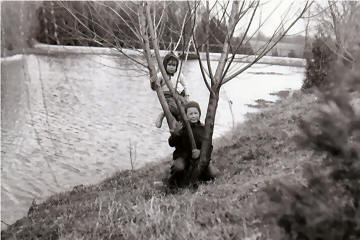
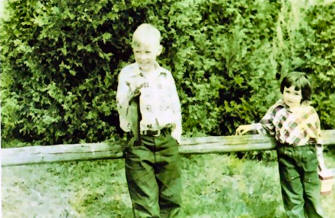
The Dogs
Mr. And Mrs. Bennett always had a series of Scottie dogs as their companions.
The dogs lived with them in the main house. Some were invariably called Hamish.
Bess was a favourite name for the female dogs. Bess was also the name of their
border collie, an invaluable outdoor dog for herding the cattle. Scott, the male
border collie, was her companion.
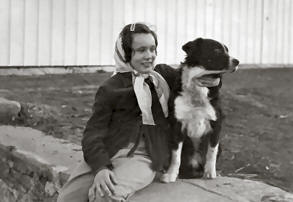
Mary and Scott (photo by Vytas Treciokas)
Once, one of the Scotties, who had become blind,
fled into the snows of winter. It took a full morning and a full team of men to
find him. Finally, in the southernmost reaches of the farm nearer the side road
to the eighth line, he was found alive sheltering under a snow bank beside a
stream.
An unmarked hill corner of the south field opposite the main house and just
below the entrance to the front bush is where the dogs are buried.
Some photographs from the
early years
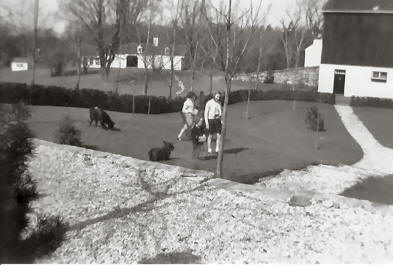
A 1940’s Easter Egg Hunt
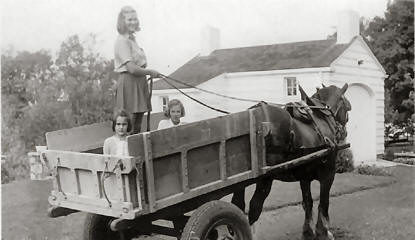
Pamela (holding the reins) and Elizabeth Bennett,
nieces of Mr. Bennett.
Scotsdale was their home during the war years. Janice Baker is seated, left
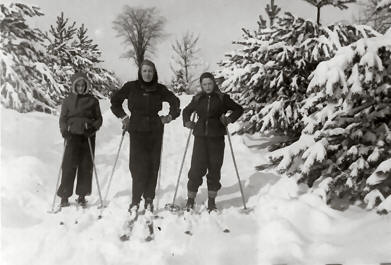
Skiing at Scotsdale. Mrs. Bennett, center.
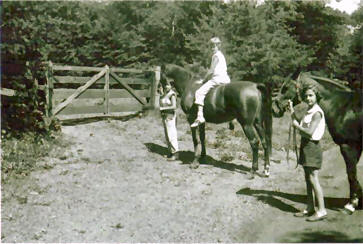
From left: Mary Baker, Betty Trott, Barbara Adams
Sources for this website include:
Reminiscences of Scotsdale by Maurice and Evelyn Baker.
(from transcribed tape recordings)
“Highlights of Shorthorn History” by Grant McEwan.
The Financial Post, March of 1953
Evelyn Baker’s Scrapbook.
The Baker Family photograph album
The Ontario Heritage Trust
Many thanks to my sister, Mary Carey, and my brother, Grant Baker,
for their support in creating this site.
Janice Treciokas
http://www.webruler.com/mtreciokas/scotsdale/
Going
back through the files I found this again. Not necessarily for posting but
thought you might be interested in a trip my parents took to Scotland in the
late 50's and what it was like then.
Janice
Going
to Scotland (1958) (M. and E. Baker)
(Dad
first went to Scotland with Mr. Bennett in 1952, when Mr. Bennett was
persuaded to purchase Prefect. In the winter of 1958 the Bennett’s sent both
Mom and Dad to Scotland, but by then the Scottish breeders had sold off the
best of their herds. Buyers had come from all over the world from the
United States, South Africa, New Zealand, Australia, Argentina and the
Scottish herds had become depleted of their best cattle. The buying spree
after the war had taken its toll.)
"We had
a terrible trip across and we had to land in Ireland ( mom speaking) We
landed in Ireland and had our breakfast and then we flew to London and Nick
met us (Nick Bennett was Mr. Bennett’s nephew and he had stayed at Scotsdale
for a few years during the war. We stayed in London for two or three days;
he showed us around the first day, and he took us on a pub crawl which we
really enjoyed and then we saw Mrs. Bennett's sister too the next day (we
had met her before) she had a home there and a little back garden and we had
tea there. We had dinner at the Savoy one night; that was a ritzy restaurant
and we had a lovely dinner there. Then we went by train to Scotland to
Castle Douglas to Jimmy Biggars. We got there one morning in the fog, and
they showed us around there and then we took the train to Perth. I remember
at Jimmy Biggars that they had hot water bottles waiting for us in our beds
and I thought that was the height of hospitality. It was so cold over there
and we appreciated the warmth. It was a big stone house and the crocuses
were in bloom; it was the end of January and this was really right out near
the Irish Sea, in the southwest corner of Scotland, and then when we got up
to Perth which is more or less in the center of Scotland, there was a huge
snowstorm and it was cold and some of the bulls never even got to the sale.
We stayed at the Station Hotel in Perth and we also were up to Calrossie’s,
the Gordon Bapton herd, which was just outside of Aberdeen. We stayed
overnight there too. Our whole trip lasted for about two weeks.
At
Gordon Blackstock’s we stayed for a couple of days, and we visited many
other of the herds and visited with the hosts. Gordon Blackstock managed the
herd for Cecil Moore who was a millionaire; he ran the football (soccer)
pools. He had this Bapton herd which he bought in England and then brought
up to Scotland. They treated us royally. We were taken to dinner one night
at the Station hotel, and then one night there was a reception and they were
dancing the highland fling up and down the huge hall. It was wonderful to
watch. At Inverness I bought the Scottish tweed for my suit and I had it
made later when I got back and do you remember I wore it for your
graduation.
The
Bennett’s had made all the plans in advance and arranged everything and we
were afforded the hospitality that they would have received had they gone.
It was a wonderful trip. We came back from Prescott and landed in Montreal.
But on that trip we didn’t buy anything. There was nothing to buy. The herds
had already been well picked over. Mr. Bennett had been over in the summer
before but there wasn’t anything there then and there still wasn’t.
“Highlights Of Shorthorn History”, 1982 by Grant MacEwan, (quotes,
chapter 24)
“What
appeared more remarkable was that the herd which drove to the top in the
shows of the ‘ 50s and ‘60s could adjust to the new type seen in the “70s
and continue to win the highest awards”…
“...early in 1970 two Bennett bred bulls Scotsdale Coinage and Scotsdale
Cromarty, both sired by Scotsdale Tehran…were bought by prominent Scottish
breeders and flown to Prestwick, Scotland by Air Canada.”
It was
an historic flight that transplanted these two promising bulls back to the
land of their ancestors. They were met at Prestwick by Col. and Mrs.
Dewhurst and a Highland piper. The Scottish cattlemen, who saw the bulls on
arrival, and later, with their first crop of calves, … were much impressed.”
Note the
contrast in delivery of the cattle between 1945 and 1970
Getting the Cattle to Canada after the war (M. Baker)
The
shipment that *John Miller bought in Scotland in the fall of 45,and Johny
Blum from Malabar Farms in Libertyville Illinois, he was over and he bought
some too. I think altogether there was close to 60 head of cattle that had
to be shipped from Scotland without any insurance and there were mines still
floating around Britain. This was six months after the war. I didn't think
Mr. Bennett was a gambling man but the insurance was so high and Johny
Miller said, "Aw, the ship won't hit a mine." They all got here and of
course it was out of Princess Deirdre that came our first grand champion
Aspiration.
Note: I
have no knowledge or record of how Calrossie Prefect, the 6100 guinea bull,
came to Canada in 1952, but presumably it was a safer passage than in 1945.

